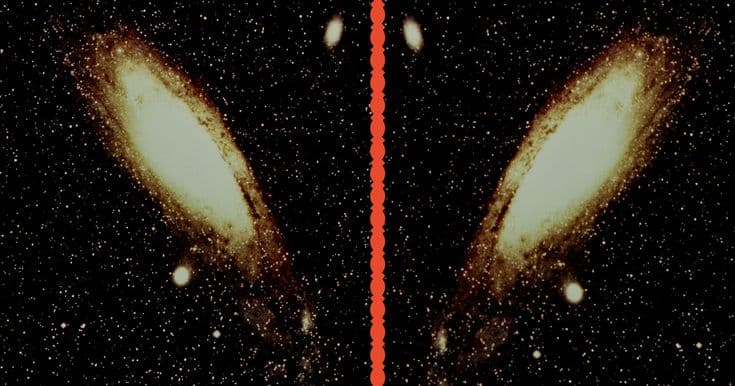The Ozma Problem, first posited by Martin Gardner in 1964, poses a fascinating challenge in astrophysics and cosmology. It explores the difficulty of communicating spatial concepts like left and right in the vast expanse of the universe, devoid of a universal reference point. This issue is not just theoretical but has practical implications in extraterrestrial communication, where establishing a common understanding of spatial orientation is crucial. The problem highlights the complexities involved in interstellar communication, underlining the fact that concepts we consider elementary may not be universally comprehensible.
The Paradox of Parity Transformation
Parity transformation, central to understanding the Ozma Problem, involves inverting an object’s spatial coordinates to create its mirror image. This concept was once considered a fundamental symmetry in physics, implying that physical laws were invariant under such transformations. However, the discovery of parity violation challenged this notion, revealing that certain physical processes, particularly those involving weak nuclear forces, behave differently when observed in a mirror. This revelation had profound implications, suggesting that the universe might not be as symmetrical as previously thought.
Chien-Shiung Wu: A Trailblazer in Physics
Chien-Shiung Wu, an eminent physicist, made groundbreaking contributions to the field of particle physics, particularly in the study of parity violation. Her experiments on the beta decay of cobalt-60 nuclei were pivotal in demonstrating that the weak nuclear force does not conform to parity symmetry. Wu’s work not only disproved a long-standing assumption in physics but also opened new avenues for research in subatomic particles and their interactions, significantly advancing our understanding of the fundamental forces of nature.
Decoding Left-Right Asymmetry in Subatomic Particles
Understanding left-right asymmetry in subatomic particles is crucial for resolving the Ozma Problem. The behavior of electron spins during certain nuclear reactions provides a key to this puzzle. Since the spin orientation of electrons remains unchanged in these reactions, it offers a unique way to define spatial directions independently of our own perspective. This approach could potentially allow for a universal standard in communicating spatial concepts across the cosmos, transcending the limitations of human-centric viewpoints.
CP-Symmetry and Its Implications
CP-Symmetry in particle physics combines two fundamental transformations: charge conjugation (C), which switches particles with their antiparticles, and parity (P), the spatial inversion. Initially, it was believed that this combined transformation would always be conserved, maintaining symmetry in all physical processes. However, the discovery of CP violation, where certain reactions do not adhere to this symmetry, challenged this principle. This breakthrough had significant implications for our understanding of the universe, particularly in explaining the predominance of matter over antimatter.
CP Violation: Unlocking the Secrets of Matter and Antimatter
CP Violation, the asymmetry between matter and antimatter in certain subatomic processes, has been a critical area of study in particle physics. The phenomenon was first observed in the decay of kaons, revealing that these particles do not decay symmetrically into matter and antimatter counterparts. This discovery has provided invaluable insights into why the universe is composed predominantly of matter, helping to solve the longstanding mystery of the matter-antimatter imbalance. It also offers a method to communicate spatial concepts across the universe by using the behavior of these particles as a reference.
Resolving the Ozma Problem: A Quantum Leap
Resolving the Ozma Problem involves leveraging the principles of CP Violation in particle decay. By observing the decay of particles like kaons in a controlled environment, scientists can establish a universal standard for left-right orientation. This method transcends the limitations of human-centric spatial concepts, offering a way to communicate these ideas to distant civilizations, potentially made of matter or antimatter. It represents a significant leap in our ability to interact and share fundamental concepts with extraterrestrial intelligence.
The Broader Impact on Particle Physics
The investigation into the Ozma Problem has far-reaching implications in particle physics. It goes beyond solving a communication challenge, delving into the fundamental properties of particles and the forces that govern them. This research contributes to our understanding of the universe’s fundamental asymmetries, including the predominance of matter over antimatter. It also enriches our comprehension of the weak nuclear force and its unique properties, challenging long-held beliefs and opening new frontiers in theoretical physics.
Comparative Table: Parity Conservation vs. Parity Violation
| Feature | Parity Conservation (Before 1956) | Parity Violation (After 1956) |
|---|---|---|
| Symmetry in Physics | Assumed in all forces | Not applicable in weak nuclear force |
| Implications for Particle Behavior | Mirror symmetry in all reactions | Asymmetry in certain subatomic processes |
| Impact on Universal Laws | Suggested universal symmetry | Revealed fundamental asymmetries |
| Experimental Evidence | Lacked testing in weak interactions | Proven in weak force interactions, e.g., beta decay |
| Perception of the Universe | Symmetrical and consistent | Complex with inherent asymmetries |
Key Insights from the Ozma Problem
- Communication Across the Cosmos: The Ozma Problem underscores the challenge of conveying spatial concepts, like left and right, without a common frame of reference in interstellar communication;
- Parity Violation Discovery: Chien-Shiung Wu’s experiment on cobalt-60 beta decay revealed the weak nuclear force’s unique non-adherence to parity symmetry, altering the course of particle physics;
- CP-Symmetry’s Role: Initially thought to be universally conserved, CP-Symmetry’s violation in certain reactions opened a new understanding of particle interactions;
- Matter-Antimatter Asymmetry: CP Violation provides crucial insights into why the universe predominantly consists of matter, addressing a fundamental question in cosmology;
- Practical Application in Extraterrestrial Communication: Observing subatomic particle decay patterns, like those of kaons, offers a potential universal method to resolve the left-right ambiguity in space.
Video Guide
To answer all your questions, we have prepared a video for you. Enjoy watching it!
The Intersection of the Ozma Problem and Freeze Laser Technology
In the realm of particle physics, the integration of concepts like the Ozma Problem with advanced technologies such as freeze laser technology presents a frontier of scientific exploration. Freeze laser technology, primarily used for cooling atoms to near absolute zero, has significant implications for studying fundamental particles and their interactions, which is central to resolving the Ozma Problem.
- Enhancing Precision in Experiments: The ability of freeze laser technology to cool particles to extremely low temperatures allows for more precise measurements and observations in experiments related to the Ozma Problem. This precision is crucial for experiments that involve parity and CP violation;
- Exploring Fundamental Symmetries: At near absolute zero temperatures, particles exhibit behavior that is essential for understanding fundamental symmetries and asymmetries in physics. Freeze laser technology facilitates this exploration, potentially offering new insights into the intricacies of the Ozma Problem;
- Implications for Quantum Communication: The use of freeze laser technology in quantum communication could have profound implications for solving the Ozma Problem in terms of establishing a universal spatial language. The precise control of quantum states at ultra-cold temperatures may provide a new approach to communicating complex spatial concepts across vast distances;
- Broader Applications in Cosmology: The insights gained from combining freeze laser technology with studies of the Ozma Problem can extend to broader cosmological questions, such as the nature of dark matter and the evolution of the universe.
Conclusion
The exploration of the Ozma Problem epitomizes the intricate and fascinating nature of particle physics. It illustrates how a seemingly simple communication challenge can unravel profound truths about the universe. This problem, straddling the realms of theoretical and experimental physics, continues to inspire and challenge physicists, driving forward our understanding of the cosmos.





